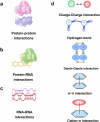Membraneless organelles in health and disease: exploring the molecular basis, physiological roles and pathological implications
- PMID: 39551864
- PMCID: PMC11570651
- DOI: 10.1038/s41392-024-02013-w
Membraneless organelles in health and disease: exploring the molecular basis, physiological roles and pathological implications
Abstract
Once considered unconventional cellular structures, membraneless organelles (MLOs), cellular substructures involved in biological processes or pathways under physiological conditions, have emerged as central players in cellular dynamics and function. MLOs can be formed through liquid-liquid phase separation (LLPS), resulting in the creation of condensates. From neurodegenerative disorders, cardiovascular diseases, aging, and metabolism to cancer, the influence of MLOs on human health and disease extends widely. This review discusses the underlying mechanisms of LLPS, the biophysical properties that drive MLO formation, and their implications for cellular function. We highlight recent advances in understanding how the physicochemical environment, molecular interactions, and post-translational modifications regulate LLPS and MLO dynamics. This review offers an overview of the discovery and current understanding of MLOs and biomolecular condensate in physiological conditions and diseases. This article aims to deliver the latest insights on MLOs and LLPS by analyzing current research, highlighting their critical role in cellular organization. The discussion also covers the role of membrane-associated condensates in cell signaling, including those involving T-cell receptors, stress granules linked to lysosomes, and biomolecular condensates within the Golgi apparatus. Additionally, the potential of targeting LLPS in clinical settings is explored, highlighting promising avenues for future research and therapeutic interventions.
© 2024. The Author(s).
Conflict of interest statement
Figures







References
-
- Gao, Y., Li, X., Li, P. & Lin, Y. A brief guideline for studies of phase-separated biomolecular condensates. Nat. Chem. Biol.18, 1307–1318 (2022). - PubMed
-
- Volkov, V. A. & Akhmanova, A. Phase separation on microtubules: from droplet formation to cellular function? Trends Cell Biol.34, 18–30 (2024). - PubMed
-
- Sahin, C., Leppert, A. & Landreh, M. Advances in mass spectrometry to unravel the structure and function of protein condensates. Nat. Protoc.18, 3653–3661 (2023). - PubMed
Publication types
MeSH terms
LinkOut - more resources
Full Text Sources
Medical

